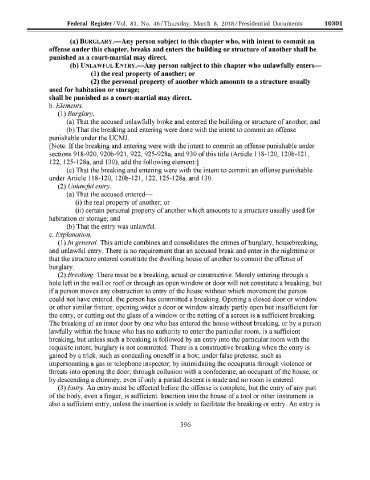Page 598 - Trump Executive Orders 2017-2021
P. 598
Federal Register / Vol. 83, No. 46 / Thursday, March 8, 2018 / Presidential Documents 10301
(a) BURGLARY.-Any person subject to this chapter who, with intent to commit an
offense under this chapter, breaks and enters the building or structure of another shall be
punished as a court-martial may direct.
(b) UNLAWFUL El'.'TRY.-Any person subject to this chapter who unlawfully enters-
( I) the real property of another; or
(2) the personal property of another which amounts to a structure usually
used for habitation or storage;
shall be punished as a court-martial may direct.
b. Elements.
(1) Burglary.
(a) That the accused unlawfully broke and entered the building or structure of another; and
(b) That the breaking and entering were done with the intent to commit an offense
punishable under the UCMJ.
[Note: If the breaking and enteting were with the intent to commit an offense punishable under
sections 918-920, 920b-921, 922, 925-928a, and 930 of this title (Article 118-120, 120b-121,
122, 125-128a, and 130), add the following element]
(c) That the breaking and entering were with the intent to commit an offense punishable
under Article 118-120, 120b-121, 122, 125-128a, and 130.
(2) Unlawful enl:ly.
(a) That the accused entered-
(i) the real property of another; or
(ii) certain personal property of another which amounts to a structure usually used for
habitation or storage; and
(b) That the entry was unlawful.
c. Lxplanation.
(1) In general. This article combines and consolidates the crimes of burglary, housebreaking,
and unlawful entry. There is no requirement that an accused break and enter in the nighttime or
that the structure entered constitute the dwelling house of another to commit the offense of
burglary.
(2) Breaking. There must be a breaking, actual or constructive. Merely entering through a
hole left in the wall or roof or through an open window or door will not constitute a breaking; but
if a person moves any obstruction to entry of the house without which movement the person
could not have entered, the person has committed a breaking. Opening a closed door or window
or other similar fixture, opening wider a door or window already partly open but insufficient for
the entry, or cutting out the glass of a window or the netting of a screen is a sufficient breaking.
The breaking of an inner door by one who has entered the house without breaking, or by a person
lawfully within the house who has no authority to enter the particular room, is a sufficient
breaking, but unless such a breaking is followed by an entry into the particular room with the
requisite intent, burglary is not committed. There is a constructive breaking when the entry is
gained by a trick, such as concealing oneself in a box; under false pretense, such as
impersonating a gas or telephone inspector; by intimidating the occupants through violence or
threats into opening the door; through collusion with a confederate, an occupant of the house; or
by descending a chimney, even if only a partial descent is made and no room is entered.
(3) Entry. An entry must be effected before the offense is complete, but the entry of any part
of the body, even a finger, is sufficient. Insertion into the house of a tool or other instrument is
sradovich on DSK3GMQ082PROD with PRES DOCS VerDate Sep<11>2014 18:39 Mar 07, 2018 Jkt 244001 PO 00000 Frm 00415 Fmt 4705 Sfmt 4790 E:\FR\FM\08MRE0.SGM 08MRE0 ER08MR18.417</GPH>
also a sufficient entry, unless the insertion is solely to facilitate the breaking or entry. An entry is
396

